If you’re considering getting a cat you have a lot of options. There are dozens of different breeds, all with their own defining characteristics and personalities. Today, we’re taking a look at the top 7 cat breeds with the longest tails.
The average cat has a tail length of about 30 centimeters (about 12 inches), but there are many breeds that have way longer tails (as well as shorter). There are different reasons why certain cat breeds have longer tails than others; some use them to keep themselves warm, while others utilize them for hunting and balancing.
Curious which cat breeds have to longest tails? Let’s find out!
1. Maine Coon
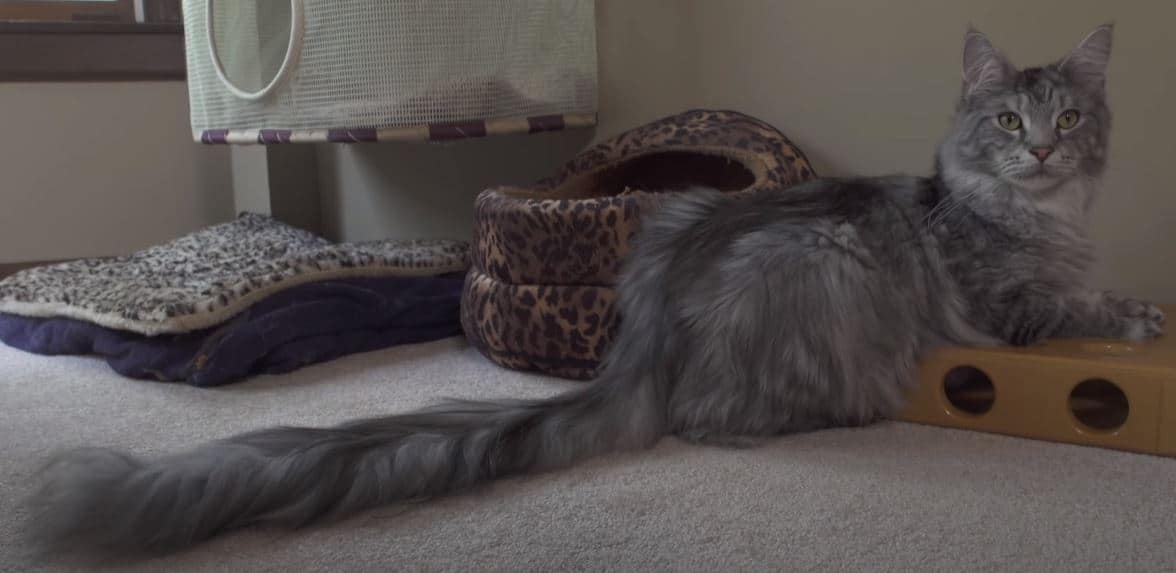
Maine Coons have the longest tails of all cats. In fact, the world record of the longest cat tail belongs to a silver Maine Coon called Cygnus Powers. Cygnus has a tail that measures an impressive 17.58 inches which is longer than the rest of his entire body combined!
Not all Maine Coons have such extremely long tails, but they do have much longer tails than other cat breeds. On average, expect the tail of a Maine Coon to be around 12-17 inches. The reason why they have such long and hairy tails is that in the wild they used it to protect themselves from cold weather. This, in combination with their thick coat, allowed the Maine Coon to survive in very cold climates.
It’s not all that surprising that Maine Coons have such long tails. After all, they are one of the largest domestic cat breeds. They boast a big, strong, and muscular body with a long coat and possess excellent hunting skills. Furthermore, Maine Coons are very affectionate, playful, and gentle. They can even be taught tricks and play fetch with their owners.
On the whole, if you’re looking for a cat breed with a long tail the Maine Coon is your best bet.
2. American Shorthair
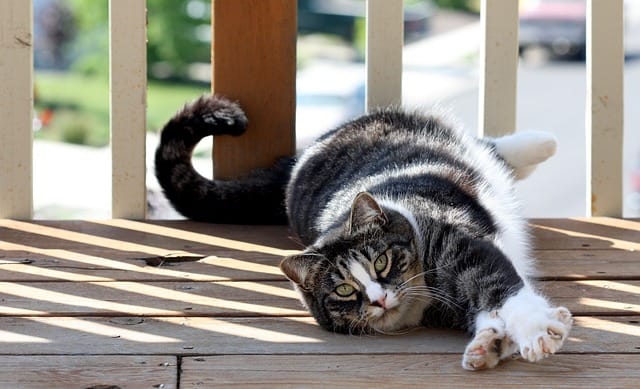
The American Shorthair is another breed that has a surprisingly long tail. Unlike many other cat breeds that boast a long tail, the American Shorthair doesn’t have a very long body. Instead, they have a stocky, muscular body, perfectly suited for hunting mice.
Their tail however is quite long relative to the rest of their body. According to the Cat Fancier’s Association (CFA), the length of the American Shorthair’s tail should be “equal to the distance from shoulder blades to the base of the tail.” In addition to its length, this breed’s tail is heavy at the base and then tapers to an abrupt blunt end.
American Shorthairs are kind, affectionate, and loving pets that are easy to groom, because of this, they’re one of the most popular breeds in the United States.
3. Balinese
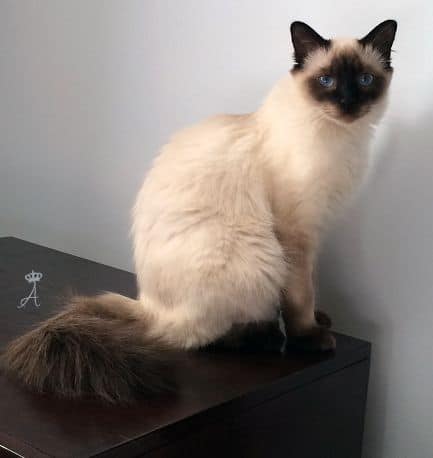
Many people mistakenly believe that the Balinese cat is native to Bali, Indonesia. This is not the case. The real origin of the Balinese cat starts in Thailand, with the Siamese cat. The Siamese cat was brought to the United States and the United Kingdom in the mid-1800s. Some of these Siamese had a gene that gave them long hair. Selective breeding made this genetic trait more pronounced and thus the Balinese were born.
The Balinese is known for its slender body, long legs, neat oval paws, almond-shaped eyes, large pointed ears, and of course, its beautiful long tail. The tail of the Balinese is not only long, but it’s also beautifully unique. It has a definite plume of longer hair at the end. In addition, the hair of their tail is often a different color than that of their body.
Balinese cats are extremely fond of people and love following their owners around the house. They are true lap cats and enjoy spending lots of time with their owners. This is an agile, intelligent, and playful breed that needs lots of mental and physical stimulation to stay happy.
Furthermore, this breed is quite chatty and is not afraid to make its demands heard. If you think a chatty, slender, graceful cat with a long tail is the right one for your household, the Balinese could be a good fit.
4. Russian Blue
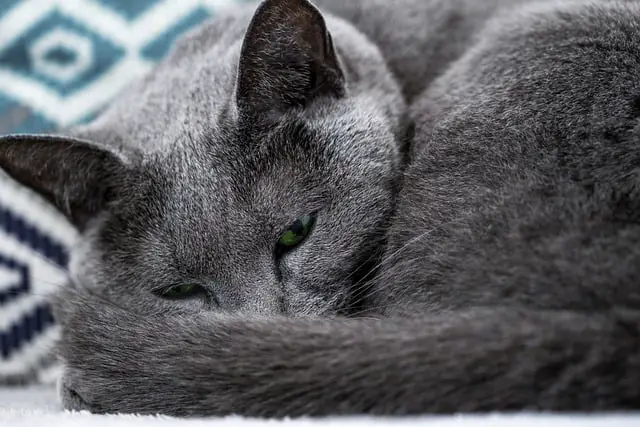
The Russian Blue has a relatively long tail, but it’s not disproportional to the rest of its body because they’re quite long cats. Their tail tapers from a moderately thick base giving them a relatively narrow tail.
They’re also known for their thick double coat that feels like silk when you pet them and rounded vivid green eyes.
The Russian Blue is, as the name suggests, native to Russia. After the devastation of two World Wars, the breed was almost extinct. Luckily, through the efforts of breeders, the Russian Blue survived and is thriving today.
The Russian Blue is known for its gentle and shy temper. It’s a relatively quiet breed that doesn’t meow a whole lot. However, just because they’re sometimes a little shy doesn’t mean that they’re boring. These cats love to play and enjoy jumping and climbing to high places where they have a good vantage point of their surroundings.
If you want a short-haired, calm-tempered, breed that has stunning green eyes, a beautifully thick, silky coat, and a magnificently long tail the Russian Blue might be the one for you.
5. Cornish Rex
View this post on Instagram
The Cornish Rex is a special kind of breed. Most cats have straight hair, but the Cornish has a curly coat. Not only that, but they also have a slender body with a remarkably long tail. The first Cornish Rex was born in Cornwall, in the UK in the 1950s, which is where the breed gets its name from.
The Cornish Rex is a slim breed, weighing only 6 to 10 pounds. They have a small, egg-shaped head, and huge ears.
The Cornish Rex is very playful and loves being a willing retriever for thrown toys. In addition, they’re an intelligent breed that loves to be the center of attention. Furthermore, they love exploring and if you leave them alone you might find that they’ve opened a closet to check out the inside.
They also enjoy being handled and like sitting on people’s laps.
These cats are active and need a stimulating environment to be happy. If that’s something you can provide for them, then they might be a good fit.
6. Egyptian Mau
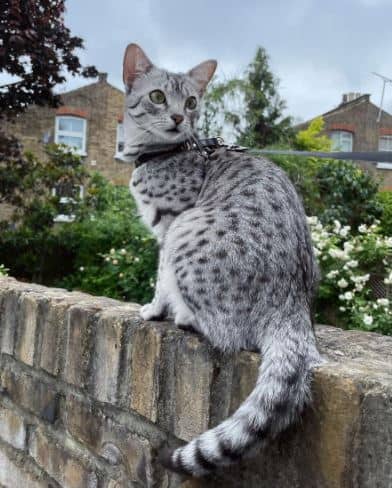
The Egyptian Mau is the fastest domesticated cat in the world. They can reach incredible speeds of up to 30 miles per hour, for reference, that’s faster than the top speed of Usain Bolt! Part of the reason why they can run so fast is because of the Egyptian Mau’s long tail.
The primary reason why the Egyptian Mau is so fast is that they have longer hind legs and a unique skin flap extending from the flank to the back knee. This skin flap allows them to run very quickly because it provides them with greater agility and length of stride.
However, another important component of why they can run so fast is their tail. The Egyptian Mau has a long tail which they use to balance themselves while running at high speeds. Funnily enough, this breed also wags their tail when they’re happy, kind of like a dog.
As the name suggests, the Egyptian Mau is native to Ancient Egypt, where they were used in duck hunts. However, since the 1950s it’s primarily been bred in the United States. They’re easy to identify because they’re one of the only domesticated cat breeds that have a spotted coat.
If speed and strength are what you’re looking for in a cat with a long tail, the Egyptian Mau might be a good choice for you. One thing to note though is that this breed is more temperature-sensitive than other breeds. They prefer warm temperatures and do not do well in the cold.
7. Norwegian Forest Cat
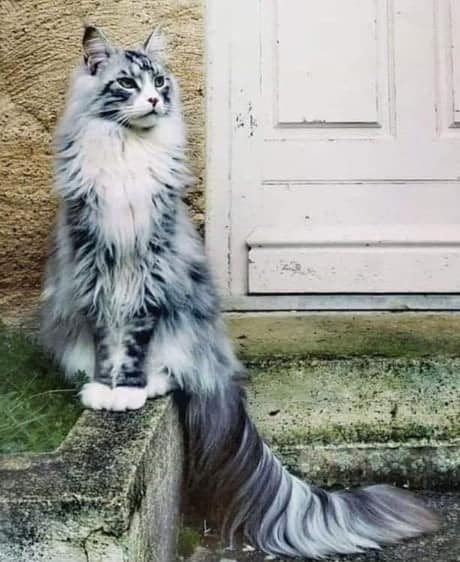
Last but not least on this list of cat breeds with long tails is the Norwegian Forest Cat.
The Norwegian Forest cat has a massive, thick tail. This breed is native to the forests of Norway. The temperatures in these forests can be very cold, which is why the Norwegian Forest Cat has evolved to have a very thick, long tail which it can use to keep itself warm. Their tail can reach a diameter of up to 20cm (~8 inches)!
The Norwegian Forest cat is sometimes a little shy around new people but once it gets to know you it’s one of the sweetest and most gentle breeds around. They enjoy the company of humans and do very well in a family environment.
- How Long Do American Eskimo Dogs Live? Important Factors and Care Tips - September 29, 2023
- Do American Bulldogs Need Grooming? Essential Tips and Care Guidelines - September 29, 2023
- Do Bengal Cats Enjoy Playing? Essential Tips for Keeping Them Active - September 29, 2023